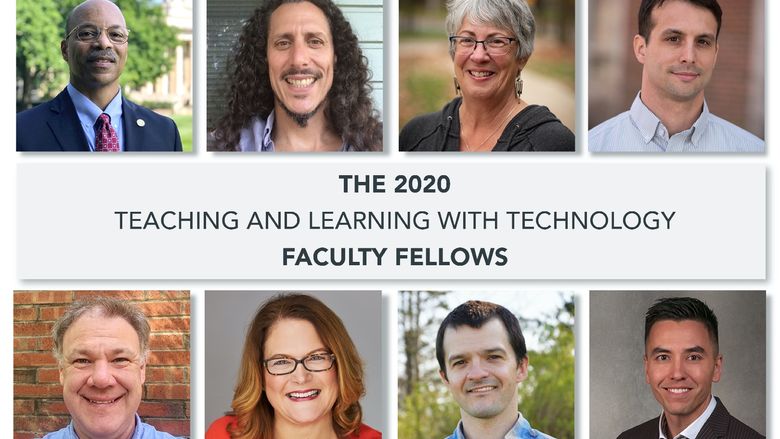
Members of the Innovative Instructional Technology in the Classroom FLC gather for an end-of-the-year meeting. From left to right: Jenifer Shannon, lecturer and College of Engineering contact and referral representative; Tara Beecham, lecturer in writing and coordinator of the common reading; Mary Ann Mengel, instructional multimedia designer; Michael Briggs, assistant teaching professor; Amy Kuntz, Teaching and Learning with Technology instructional designer; Dawn Pfeifer Reitz, lecturer in communication, arts and sciences; Catherine Catanach, lecturer in communication, arts and sciences; Jennifer Dareneau, associate teaching professor; Bryan Wang, assistant teaching professor of biology; and Donna Chambers, assistant teaching professor of Spanish.
A diverse group of faculty members at Penn State Berks have come together to collaborate on creative ways to use technology to transform the classroom. Founded in spring 2018, the Teaching and Learning with Technology (TLT) Faculty Learning Community (FLC) for Innovative Instructional Technology in the Classroom has been looking critically at how they can help foster innovative strategies for teaching and learning.
“The FLC was launched as a kind of book group, but some of the richest collaborative moments for me have spun out of digressions into our own teaching challenges and solutions,” said Bryan Wang, an FLC member and assistant teaching professor of biology.
The FLC, part of an initiative started by Penn State TLT and one of eight FLCs formed during the 2018-19 academic year, was founded by Dawn Pfeifer Reitz, lecturer in communication arts and sciences and Communication, Arts and Sciences 100: Effective Speech coordinator, to increase interdepartmental collaboration while using innovative technologies that enhance teaching and learning. After brainstorming with campus instructional and multimedia designer Mary Ann Mengel, the Innovative Instructional Technologies in the Classroom FLC was born, and the plan is to continue it through the 2019-20 academic year for existing members and broaden the reach for additional interested faculty.
“I am enthusiastic about incorporating technology into my classroom,” Pfeifer Reitz said. "My goal was to meet faculty across our campus and talk with likeminded folks interested in incorporating tech into teaching."
Since September 2018, the FLC group of 11 members would meet every three weeks to talk about an assigned book and lessons learned. At the end of each meeting, a member volunteered to write a blog post about what they discussed.
“One theme that we discussed early on focused on the challenge of designing courses that provide students space to exercise creativity,” Wang said. In Wang’s senior-level laboratory in molecular genetics course in the spring, his students created final projects using a variety of media, from a Facebook page for a fictional researcher to a whodunit graphic novella, all of which were based upon a molecular cloning and phylogeny project. Students showed an increased interest when creating and crafting their projects, and a rise in engagement was exhibited through the final week of classes.
Jenifer Shannon, a lecturer in electrical engineering, is another FLC member who has seen success from applying ideas discussed during the group’s meetings. She began developing strategies to incorporate interactive online materials to her lecture content including using Kaltura for video editing, interactive video quizzes, and providing students with more time in the lab.
"The diversity of our members' academic backgrounds contributes to an exciting and fruitful FLC group,” Shannon said. “We bounce our ideas off each other and offer encouragement and suggestions.”
Thanks to the FLC and support from Mengel, Pfeifer Reitz has implemented a more formal way for students to use Zoom to enhance their listening skills. She has introduced a “persuasive Zoom review” into her classes, where students deliver persuasive speeches, watch each other’s speeches, then hold recorded meetings through Zoom to give each other feedback.
Afterward, Pfeifer Reitz evaluates their Zoom reviews based upon how well they met the requirements of the assignment. Each student is required to provide feedback on their partner’s speech, consider the feedback and ask two to three follow-up questions, and the entire Zoom meeting should be four to five minutes, with two to two and a half minutes allocated per student.
Pfeifer Reitz said, "FLC groups like these are invaluable. The concept of the 'critical friend'—developing collegial relationships, encouraging reflective practice, and rethinking process together—helps make all of us better at what we do in our own classrooms.”
For more information about the Teaching and Learning with Technology (TLT) Faculty Learning Community (FLC) for Innovative Instructional Technology in the Classroom, contact Dawn Pfeifer Reitz.




